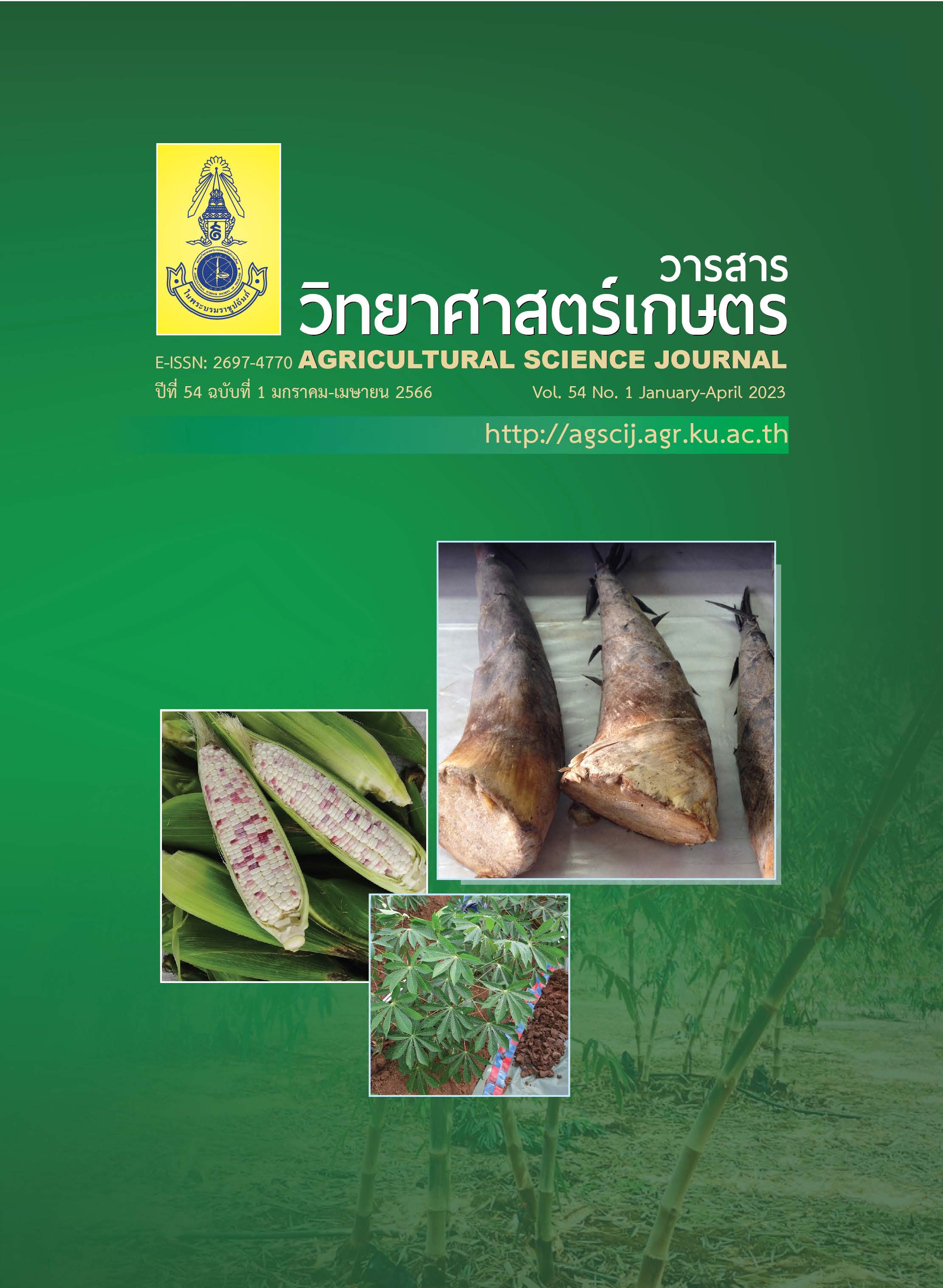การใช้ Quantity/Intensity (Q/I) concept เพื่อประมาณปริมาณปุ๋ยโพแทสเซียมสำหรับข้าวโพดหวานที่ปลูกในชุดดินตาคลี
Main Article Content
บทคัดย่อ
แนวความคิด Quantity/Intensity (Q/I) ใช้ประเมินโพแทสเซียมในดินเพื่อการจัดการปุ๋ยได้อย่างมีประสิทธิภาพ จึงได้ศึกษาโพแทสเซียมในชุดดินตาคลีโดยใช้แนวความคิด Q/I เพื่อประมาณอัตราปุ๋ยโพแทสเซียมที่เหมาะสมสำหรับข้าวโพดหวานพันธุ์อินทรี 2 และพันธุ์สงขลา 84–1 ในโรงเรือนทดลอง วางแผนการทดลองแบบบล็อกสุ่มสมบูรณ์จำนวน 10 ตำรับการทดลอง คือ ไม่ใส่โพแทสเซียม ใส่ปุ๋ยโพแทสเซียมที่ 0.5 1.0 และ 1.25 เท่าของโพแทสเซียมที่ประมาณจากค่าความเข้มข้นของโพแทสเซียมที่เป็นประโยชน์ต่อพืช (ARke) โดยใส่ทางดินครั้งเดียว หรือแบ่งใส่ทางดินสองครั้ง หรือแบ่งใส่ทางดินและฉีดพ่นทางใบ โดยอัตราปุ๋ยที่ ARke เท่ากับ 25.58 มิลลิกรัม K2O ต่อกิโลกรัม ผลการศึกษา พบว่า การใส่ปุ๋ยโพแทสเซียมที่ประมาณจาก ARke ในทุกอัตราไม่มีผลต่อผลผลิตของข้าวโพดหวานพันธุ์อินทรี 2 แต่ทำให้น้ำหนักฝักสดข้าวโพดหวานพันธุ์สงขลา 84–1 เพิ่มขึ้นได้ไม่แตกต่างกัน (42.23–52.40 กรัมต่อกระถาง) ยกเว้นที่ 0.5ARke (P < 0.01) การใส่โพแทสเซียมที่ ARke และ 1.25ARke ต่างเพิ่มความหวาน (22.0–22.7 และ 13.0–13.7 องศาบริกซ์) และปริมาณน้ำตาลรีดิวซ์ (121–141 และ 102–120 มิลลิกรัมต่อลิตร) ของข้าวโพดหวานพันธุ์อินทรี 2 (P < 0.01) และสงขลา 84–1 (P < 0.01) ได้ไม่แตกต่างกัน การใส่ปุ๋ยครั้งเดียวให้ผลผลิตและคุณภาพของข้าวโพดหวานส่วนใหญ่มีค่าสูงกว่าการแบ่งใส่เมื่อใส่ปุ๋ยในอัตราเดียวกัน ดินหลังปลูกข้าวโพดมีโพแทสเซียมที่ละลายน้ำ (P < 0.05) และที่แลกเปลี่ยนได้ (P < 0.01) เพิ่มขึ้นอย่างมีนัยสำคัญทางสถิติ ยกเว้นการใส่ที่ 0.5ARke นอกจากนี้ โพแทสเซียมพารามิเตอร์ที่ประเมินจาก Q/I เพิ่มขึ้นทางสถิติ (P < 0.01) ค่า ARke ประเมินระดับความเป็นประโยชน์ของโพแทสเซียมในดินเพื่อจัดการปุ๋ยได้แต่ควรนำไปศึกษาเพิ่มเติมในสภาพไร่นา
Article Details

อนุญาตภายใต้เงื่อนไข Creative Commons Attribution-NonCommercial-NoDerivatives 4.0 International License.
เอกสารอ้างอิง
Aown, M., S. Raza, M.F. Saleem, S.A. Anjum, T. Khaliq and M.A. Wahid. 2012. Foliar application of potassium under water deficit conditions improved the growth and yield of wheat (Triticum aestivum L.). J. Anim. Plant Sci. 22(2): 431–437.
Beckett, P.H.T. 1964. Studies on soil potassium II. The ‘immediate’ Q/I relations of labile potassium in the soil. Eur. J. Soil Sci. 15(1): 9–23.
Beckett, P.H.T. 1972. Critical cation activity ratios. Adv. Agron. 24: 379–412.
Bedrossian, S. and B. Singh. 2004. Potassium adsorption characteristics and potassium forms in some New South Wales soils in relation to early senescence in cotton. Aust. J. Soil Res. 42(7): 747–753.
Cakmak, I. 2010. Potassium for better crop production and quality. Plant Soil. 335: 1–2.
Chai Nat Field Crops Research Center. 2019. Production Sweet Corn Hybrid Variety Handbook. Field and Renewable Energy Crops Research Institute, Department of Agriculture, Bangkok, Thailand. (in Thai)
Chalernthai, P. and C. Santasup. 2018. Effects of potassium fertilizer on quality and yield of sweet corn in Ngao district, Lampang province. Journal of Agriculture 34(1): 29–40 (in Thai)
Department of Agriculture. 2005. Recommended Rate of Fertilization for Economic Crops. Available Source: http://lib.doa.go.th/multim/e–book/EB00271.pdf, November 11, 2020. (in Thai)
Evangelou, V.P., A.D. Karathanasis and R.L. Blevins. 1986. Effect of soil organic matter accumulation on potassium and ammonium quantity-intensity relationships. Soil Sci. Soc. Am. J. 50(2): 378–382.
Havlin, J.L., J.D. Beaton, S.L. Tisdale and W.L. Nelson. 2005. Soil Fertility and Fertilizers: An Introduction to Nutrient Management. 7th edition. Prentice Hall, New Jersey, USA.
Jackson, M.L. 1965. Soil Chemical Analysis: Advanced Course. Department of Soils, University of Wisconsin, Wisconsin, USA.
Jiang, W., X. Liu, Y. Wang, Y. Zhang and W. Qi. 2018. Responses to potassium application and economic optimum K rate of maize under different soil indigenous K supply. Sustainability. 10: 2267.
Johnson, C.M. and A. Ulrich. 1959. Analytical methods for use in plant analysis, pp. 26–78. In Bulletin of the California Agricultural Experiment Station No. 766. Berkeley, California, USA.
Lu, Q., D. Jia, Y. Zhang, X. Dai and M. He. 2014. Split application of potassium improves yield and end-use quality of winter wheat. Agron. J. 106(4): 1411–1419.
Mam Rasul, G.A. 2010. Effect of potassium fertilizer on growth and yield of corn plants in some soils at Sulaimani Governorate. Mesopotamia J. Agric. 38(1): 35–44.
Mann, R.L., P.S. Kettlewell and P. Jenkinson. 2004. Effect of foliar-applied potassium chloride on septoria leaf blotch of winter wheat. Plant Pathol. 53(5): 653–659.
Mengel, K. and E.A. Kirby. 1987. Principles of Plant Nutrition. International Potash Institute, Bern, Switzerland.
Miller, G.L. 1959. Use of dinitrosalicylic acid reagent for determination of reducing sugars. Anal. Chem. 31(3): 426–428.
Minjian, C., Y. Haiqiu, Y. Hongkui and J. Chungji. 2007. Difference in tolerance to potassium deficiency between two maize inbred lines. Plant Prod. Sci. 10(1): 42–46.
Pettigrew, W.T. 2008. Potassium influences on yield and quality production for maize, wheat, soybean and cotton. Physiol. Plant. 133(4): 670–681.
Pratt, P.F. 1965. Potassium, pp. 1022–1030. In C.A. Black, ed. Method of Soil Analysis. Part 2. Chemical and Microbiological Properties. Agronomy No. 9. American Society of Agronomy, Inc., Madison, Wisconsin, USA.
Rao, C.S., A.S. Rao, K.V. Rao, B. Venkateswarlu and A.K. Singh. 2010. Categorisation of districts based on nonexchangeable potassium: implications in efficient K fertility management in Indian agriculture. Indian J. Fert. 6: 40–54.
Richards, J.E. and T.E. Bates. 1988. Studies on the potassium-supplying capacities of southern Ontario soils. II. Nitric acid extraction of nonexchangeable K and its availability to crops. Can. J. Soil Sci. 68(2): 199–208.
Saleque, M.A., M. Anisuzzaman and A.Z.M. Moslehuddin. 2009. Quantity–intensity relationships and potassium buffering capacity of four Ganges river floodplain soils. Commun. Soil Sci. Plant Anal. 40: 1333–1349.
Suttanukool, P., T. Darunsontaya and W. Jindaluang. 2019. A study on the quantity/intensity relationships of potassium of sugarcane growing soils, eastern Thailand. Commun. Soil Sci. Plant Anal. 50(2): 153–163.
Suwanarit, A. and M. Sestapukdee. 1989. Stimulating effects of foliar K-fertilizer applied at the appropriate stage of development of maize: a new way to increase yield and improve quality. Plant Soil. 120: 111–124.
Wang, J.J. and A.D. Scott. 2001. Effect of experimental relevance on potassium Q/I relationships and its implications for surface and subsurface soils. Commun. Soil Sci. Plant Anal. 32(15–16): 2561–2575.
Wang, J.J., D.L. Harrell and P.F. Bell. 2004. Potassium buffering characteristics of three soils low in exchangeable potassium. Soil Sci. Soc. Am. J. 68(2): 654–661.
Zharikova, E.A. 2004. Potential buffer capacity of soils with respect to potassium (by the example of the Amur River region). Eurasian Soil Sci. 37(7): 710–717.


